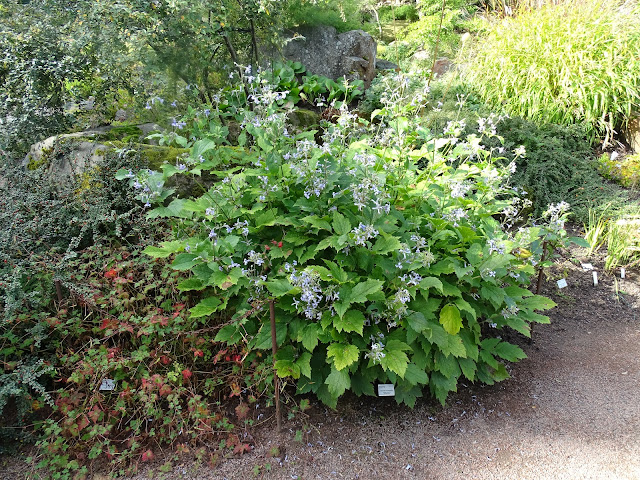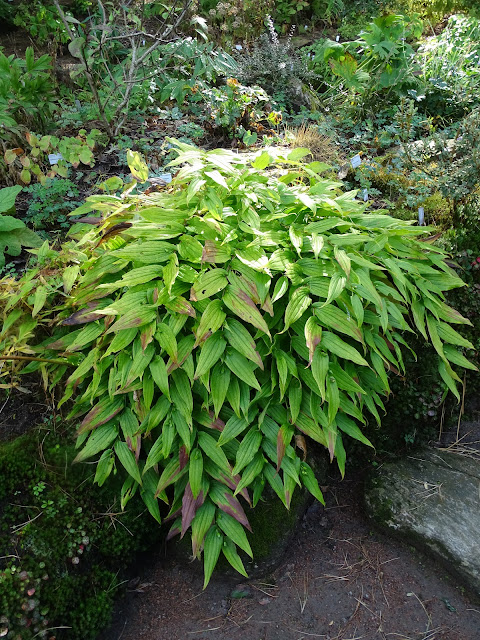 |
| Habenaria medusae |
Before launching onto the outside grounds (as is my wont), I must give a bit of balance by stressing that Gothenburg Botanic Garden is not just about bulbs, alpines and cushion plants! There is a full deck of botanical wonders including extensive indoor collections. This astonishing bank of the infrequently seen (and challenging) Indonesian cousin to our native American fringed orchids really impressed me, and seems to be a good place to launch this second half of my Swedish rhapsody (May I suggest you click and stream
this Youtube rendition of Hugo Alfvén's classic of that name--which has haunted me since my childhood with it's rich, romantic pastoral beauty): it makes for lyrical and appropriate accompaniment! So let's start with a stroll through the tropicals...
 |
Habenaria medusae closeup
|
And to think it's related to our many north Temperate Habenarias...one wonders if they'll ever cross?
 |
| I'm always impressed with insectivorous plants which I find tricky to grow |
 |
| Disas make lovely companions for these |
As might be expected, I was especially captivated by the
Disa display...
One doesn't often see Heliamphoras so well grown in botanic gardens. Love the sphagnum throughout.
 |
| Finally we venture out onto the grounds again... |
From a distance this grand border looked stunning: Gothenburg is big enough (and our time was insufficient) that I never got back to explore this more closely....next time perhaps?
 |
| And now we venture into the woods! |
 |
| An extensive forest, 100 and more years old is the scene for one of the most ambitious gardens here since my last visit. Several acres of woods are beautifully maintaned with an underplanting that is astonishing in its range and artistry. |
 |
| Johan Nilson |
Johan showing off some of the truly magnificent old firs (no, he's not holding it up or vice versa), this one is
Abies homolepis
Gazing upwards in the same fir...
The group was enchanted and began to wander all over the place!
 |
| Podophyllum aurantiocaule with ripe pods |
 |
| It helps that there are such dramatic rock features here and there--all mossy with age. |
There's abundant interpretation around the Gardens: as with most European gardens this is often fairly detailed: they don't believe in talking down to their audience or assuming everyone's a dunce.
 |
| Chrysosplenium davidianum |
I've visited many woodland gardens, but few so lush and mature.
 |
| Matteucia orientalis |
 |
| A closer look at the Matteucia--one I'd love to try! No as rambunctious as our native Eastern species. |
If you couldn't tell, I was enchanted with this woodland space. A garden at once utterly natural, yet contemplative like a Japanese garden, and an unbelievable trove of woodland treasures.
Now on to the rock garden! Wooo HOOOO!
Like all the great rock gardens, this one is impossible to really capture on film: it's meant to be seen close at hand. Here for example--lots of green--but notice the waterfall in the distance: this sucker is enormous!
The rock garden from a different angle. Rock gardens are so often similar in form--a mound next to the pond whence the mound came: this one is built on a naturally rocky site with huge elevation gradients. It's organized geographically. And chockablock full of great plants.
I tried to show how radically different the views are from every angle. As much as I like perennial borders, they're all basically two dimensional and similar to one another. Rock gardens are the ultimate horticultural expression of diversity.
There's even a tunnel/grotto: how cool is that (literally and figuratively)!
I love the way things pop out, like the blood grass above. Not invasive here either!
Being September (and being Gothenburg) there are charming displays of colchicums as you'd expect!
Pearly everlasting--which seems to grow everywhere in the northern Hemisphere!
Love the little bog tucked in here with a very happy pitcher plant.
 |
| Clematis ochroleuca |
And of course I have to come to Europe to see a native American clematis grown superbly!
For some this may seem a bit wild. Too bad for those "some"--late autumn in a meadow ought to be wild!
 |
| Betula michauxii |
A new prostrate birch I'd never seen before from Canada.
 |
| Sarracenia purpurea |
 |
| Eriogonum umbellatum v. porteri |
A huge mat of one of our best alpine buckwheats from the West--bigger than what I've seen in the wild!
 |
| Tsuga canadensis 'Pendula' |
A spectacular specimen of weeping hemlock
 |
| the American Shortia galacifolia in wonderful fall color |
 |
| And its cousin it claims to resemble (Galax aphylla) |
 |
| Parochetus communis |
They apparently have a hardy form of this spectacular pea from the Himalaya that ventures across to Africa. The forms grown in North America seem to be tender.
Not an easy plant to grow in Denver--this
Cyananthus lobatus x microphyllus inspired me to try it again!
 |
| A great planting of Patrinia triloba |
About the same size as
Patrinia sibirica we saw in the Altai--only quite different in effect.
I believe this is
Allium beesianum.
 |
| Sempervivum globiferum |
One doesn't often see a sempervivum grown so well!
 |
| Aconogonon (Polygonum) tortuosum |
 |
| A perfect specimen of Clematis heracleifolia |
We once had a similar specimen. Now we have masses of a dwarfer deep blue one. All are good!
 |
| Woodsia kitadakensis |
 |
| Saxifraga cherlerioides var rebunshirensis |
A wonderful carpet of what appears to be a mossy saxifrage from Japan: the label says it comes from Hiroshima (which resonates in other ways)...
 |
| A composite--probably a Ligularia--whose label I forgot to photograph! |
So many plants that are new to me: the wonder of botanic gardens.
 |
| Coniogramme intermedia |
A fantastic fern I'd not seen before that looks almost tropical to my eyes. But obviously growing happily in Sweden.
I was so enchanted by the artistic way this
Hosta minor was tucked into the crevice
I forgot to photograph the label...perhaps Johan will save me once again!? [Johan came to the rescue as I'd hoped.]
 |
| Berneuxia tibetica |
Yet another of the almost mythical Diapensiaceae that Gothenburg is justly famous for collecting.This Tibetan gem is obviously very happy here. I just missed it in bloom my last visit (a few weeks to early) and came too late in June to see it my first time. I must go back in late April next time!
 |
| Patrinia gibbosa |
 |
| Tricyrtis macrantha (I believe) |
A few weeks too early to see the stunning yellow bells of this wonderful toad lily...
 |
| Shortia uniflora and soldanelloides crowding a path |
These steps would be beautiful if the plants surrounding them were common--but instead they are "just" various
Shortia from Japan, duking it out...for a plantsman, this is Nirvana!
It was right about here than Johan sighed next to me, explaining that the Shortias are so vigorous they have trouble growing other choice plants near by: they smother them out! You can imagine how sorry I felt for him and Gothenburg at this point...
 |
Shortia soldanelloides Vaccinium praestans, rather, in fall color |
I have dozens more pictures I'd love to share...and perhaps during this long winter, I'll have time to go back and do better justice to this place. I fear there could be a part III, or even a part IV! But right now, how can one dare add anything beyond this shot of a fulminating masses of
Shortia and this astonishing bilberry in fall color? About a good a close as one could wish, don't you think?
I believe the Alpine Garden Society is planning a tour to Gothenburg next spring--if there's still room on that tour, I'd strongly suggest taking it. If you're not coming with me to China that is!









































































Try growing Pinguicula. They are as easy as African Violets. I keep mine in a terrarium adjacent to a sunny south facing window with the top cracked for a little ventilation. A terrarium keeps the humidity higher than it is in the rest of my house. I have had mine for over 15 years and don't need to water them often because the terrarium holds moisture for a long time.
ReplyDelete